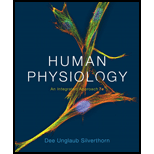
Human Physiology: An Integrated Approach (7th Edition)
7th Edition
ISBN: 9780321981226
Author: Dee Unglaub Silverthorn
Publisher: PEARSON
expand_more
expand_more
format_list_bulleted
Concept explainers
Question
Chapter 25, Problem 12RQ
a.
Summary Introduction
To determine: The similarities and differences between ATP, ADP, and PCr with respect to exercise.
Introduction: Skeletal muscles have smooth muscles cells present in them. The contraction of these muscles is the first process which takes place during exercise. Exercise is an active process which requires ATP as an energy supplement.
b.
Summary Introduction
To determine: The similarities and differences between myoglobin and hemoglobin with respect to exercise.
Introduction: Mitochondria are the “powerhouse” of the cell. The demand for energy increases during strenuous activity. This energy is produced with the help of oxygen, which enters into the mitochondria through globin proteins.
Expert Solution & Answer
Want to see the full answer?
Check out a sample textbook solution
Students have asked these similar questions
What is behavioral adapt
22. Which of the following mutant proteins is expected to have a dominant negative effect when over-
expressed in normal cells?
a. mutant PI3-kinase that lacks the SH2 domain but retains the kinase function
b. mutant Grb2 protein that cannot bind to RTK
c. mutant RTK that lacks the extracellular domain
d. mutant PDK that has the PH domain but lost the kinase function
e. all of the above
What is the label ?
Chapter 25 Solutions
Human Physiology: An Integrated Approach (7th Edition)
Ch. 25 - If venous PO2 decreases as exercise intensity...Ch. 25 - In Figure 25.8b, why does the line for mean blood...Ch. 25 - The active vasodilator nerves to the skin secrete...Ch. 25 - Name the two muscle compounds that store energy in...Ch. 25 - Prob. 2RQCh. 25 - Prob. 3RQCh. 25 - Prob. 4RQCh. 25 - Prob. 5RQCh. 25 - What is meant by the term oxygen deficit, and how...Ch. 25 - Prob. 7RQ
Ch. 25 - In endurance events, body temperature can reach...Ch. 25 - Prob. 9RQCh. 25 - Prob. 10RQCh. 25 - Prob. 11RQCh. 25 - Prob. 12RQCh. 25 - Match the following brain areas with the...Ch. 25 - Specify whether each of the following parameters...Ch. 25 - Why doesnt increased venous return during exercise...Ch. 25 - Diagram the three theories that explain why the...Ch. 25 - Prob. 17RQCh. 25 - Explain how exercise decreases blood glucose in...Ch. 25 - Prob. 19RQCh. 25 - Prob. 20RQCh. 25 - The following graph shows left ventricular...
Knowledge Booster
Learn more about
Need a deep-dive on the concept behind this application? Look no further. Learn more about this topic, biology and related others by exploring similar questions and additional content below.Similar questions
- Can you described the image? Can you explain the question as well their answer and how to get to an answer to an problem like this?arrow_forwardglg 112 mid unit assignment Identifying melting processesarrow_forwardGive only the mode of inheritance consistent with all three pedigrees and only two reasons that support this, nothing more, (it shouldn't take too long)arrow_forward
- Oarrow_forwardDescribe the principle of homeostasis.arrow_forwardExplain how the hormones of the glands listed below travel around the body to target organs and tissues : Pituitary gland Hypothalamus Thyroid Parathyroid Adrenal Pineal Pancreas(islets of langerhans) Gonads (testes and ovaries) Placentaarrow_forward
- What are the functions of the hormones produced in the glands listed below: Pituitary gland Hypothalamus Thyroid Parathyroid Adrenal Pineal Pancreas(islets of langerhans) Gonads (testes and ovaries) Placentaarrow_forwardDescribe the hormones produced in the glands listed below: Pituitary gland Hypothalamus Thyroid Parathyroid Adrenal Pineal Pancreas(islets of langerhans) Gonads (testes and ovaries) Placentaarrow_forwardPlease help me calculate drug dosage from the following information: Patient weight: 35 pounds, so 15.9 kilograms (got this by dividing 35 pounds by 2.2 kilograms) Drug dose: 0.05mg/kg Drug concentration: 2mg/mLarrow_forward
- A 25-year-old woman presents to the emergency department with a 2-day history of fever, chills, severe headache, and confusion. She recently returned from a trip to sub-Saharan Africa, where she did not take malaria prophylaxis. On examination, she is febrile (39.8°C/103.6°F) and hypotensive. Laboratory studies reveal hemoglobin of 8.0 g/dL, platelet count of 50,000/μL, and evidence of hemoglobinuria. A peripheral blood smear shows ring forms and banana-shaped gametocytes. Which of the following Plasmodium species is most likely responsible for her severe symptoms? A. Plasmodium vivax B. Plasmodium ovale C. Plasmodium malariae D. Plasmodium falciparumarrow_forwardStandard Concentration (caffeine) mg/L Absorbance Reading 10 0.322 20 0.697 40 1.535 60 2.520 80 3.100arrow_forwardPlease draw in the missing answer, thank youarrow_forward
arrow_back_ios
SEE MORE QUESTIONS
arrow_forward_ios
Recommended textbooks for you
- Nutritional Sciences: From Fundamentals to Food, ...Health & NutritionISBN:9781337486415Author:McGuirePublisher:CengageLifetime Physical Fitness & WellnessHealth & NutritionISBN:9781337677509Author:HOEGERPublisher:Cengage

Nutritional Sciences: From Fundamentals to Food, ...
Health & Nutrition
ISBN:9781337486415
Author:McGuire
Publisher:Cengage


Lifetime Physical Fitness & Wellness
Health & Nutrition
ISBN:9781337677509
Author:HOEGER
Publisher:Cengage



KINE 2310-Chapter 4: Philosophy of Physical Activity; Author: HBU Online Course Development;https://www.youtube.com/watch?v=8Ky6t3nvP_4;License: Standard youtube license